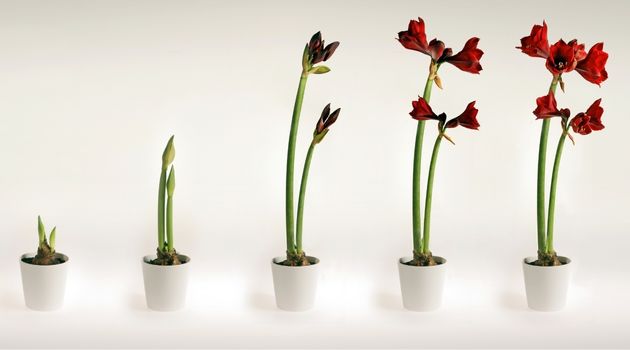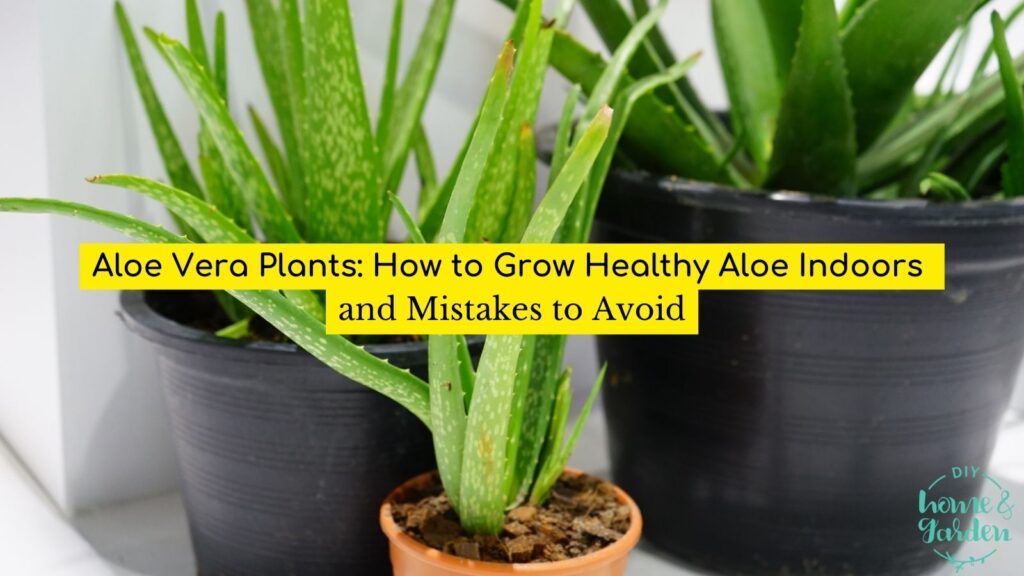Amaryllis, (Hippeastrum spp.), are probably the most effortless bulbs to grow and care for yet are unbeatable for their sheer flower power.
Native to the tropical regions of Central and South America, the baseball-size bulbs (often sold around the holidays) unfurl large, trumpet-shaped blooms atop one to two-foot-tall stems.
They’re a perfect gift for both novice and experienced gardeners.
White and red are the familiar amaryllis flower tones, but they also come in shades of orange, pink, rose, and deep burgundy. Others combine these beautiful color stripes in a single bloom.
Whether grown indoors or outdoors, these beauties stay true to their course—brightening up any space in your home.
Frequently Asked Questions about Amaryllis
Before diving into the planting and care process, here are the answers to some frequently asked questions about amaryllis.
Do amaryllis bulbs come back every year?
Amaryllis is a tender perennial, meaning it will grow, bloom, and re-bloom throughout the year—with proper care.
How long do amaryllis bulbs live?
Most amaryllis varieties will average at 25 years, though it’s not uncommon to hear of heirloom cultivars that have survived for sixty or more years down generations.
How do I keep my amaryllis bulb for next year?
Preserve your amaryllis bulb for the next season by storing it in a cool, dark, dry location like the basement or an unheated but attached garage—with temperatures between 50-550F for 8-12 weeks.
Alternatively, observing the same temperature range, keep the bulbs in your refrigerator’s crisper section, but not together with apples—to avoid the possibility of sterilization.
What month do amaryllis bloom?
Amaryllis blooms in the spring and winter.
How many times will an amaryllis bulb bloom?
This may vary depending on the amaryllis variety, but most bulbs generally set forth two or three bloom cycles each season.
How long does amaryllis stay in bloom?
Once the flowers are birthed from the buds, they last three to seven days—depending on the growing conditions.
In a dry indoor environment, for instance, the flowers will quickly fade away unless you offer them a boost of humidity, which can be either through a humidifier or a spray bottle.
What do you do with amaryllis bulbs after they bloom?
It depends. You can opt to discard or preserve the bulbs for a re-bloom the following season.
Will amaryllis bulbs multiply?
Yes, amaryllis multiplies if offered the proper care. You’ll notice your healthy mature bulbs producing secondary “offset” bulbs, which you can remove and repot as new plants.
When should I put amaryllis in the dark?
In mid-late August, begin with-holding water to let the foliage shrink back naturally, allowing the pot to dry out completely.
Then relocate the bulb to a cool, dry, and dark spot, free of insects and rodents.
What time of year do you transplant amaryllis?
Amaryllis is best transplanted in early fall—as new growth sets in.
You’ll know it’s ready for repotting when the leaves brown off and become crispy, and some tiny, fresh, green growth emerges from the bulb.
Do you deadhead amaryllis?
You may deadhead your amaryllis if you intend to re-bloom it the following growing season.
Remove all the spent blooms to prevent the plant from going to seed. Be sure to cut off only the brown or yellow stalks or those already withering.
Why is my amaryllis only growing leaves?
It’s normal for amaryllis to set forth leaves first, then the flower stalks afterward. And sometimes it’s the other way round. So don’t fret.
To encourage flower stalk development, locate the plant in a bright spot.
At times, the all-leaves-and-no-flowers thing can be the plant’s way of communicating “fatigue”—especially when you try to get it to re-bloom too quickly.
The bulbs often need time to store nutrients and then enter a rest period.
Can I put my amaryllis outside?
Because they’re tropical and won’t survive cold weather, only move them out once all the danger of frost is gone. Of course, unless you live in a tropical climate.
Precisely, initiate outdoor planting once the temperature hits 70° F late in the spring or early summer.
Are amaryllis cold hardy? Can amaryllis stay outside in winter?
Being tropical, amaryllis prefers warm temperatures. Outdoors it’s hardy to zone eight, but you can sometimes over-winter it in the garden in zone seven—if you heavily mulch the soil.
How often do you water amaryllis?
Keep the potting mix slightly moist until leaves and/or flower shoots sprout from the bulb. Once your amaryllis is actively growing flowers and leaves, irrigate only when the top inch of the soil feels dry.
Water enough to moisten the entire root ball, making sure to drain off any excess water from the cachepot or saucer.
What do you do with amaryllis babies?
Amaryllis babies make great gifts, but you can also repot them to increase your collection.
Why do we use an amaryllis at Christmas?
Amaryllis is a ‘sparkle.’ It’s a Christmas darling considering its colorful blooms, especially the immense showy white and red flowers that not only make for perfect gifts but also lift almost any holiday décor theme.
Planting Amaryllis Bulbs Indoors
It’s easier than you thought!
Begin by choosing your amaryllis bulbs. Ensure they’re greenish-white in color and firm to the touch, with a visible bud tip.
The outer thin layers of the bulb may appear brownish (onion-like)—this is normal.
If purchasing online, choose a retailer known for large healthy bulbs. That way, you’re sure that even if there are no visible buds, the bulbs will eventually still produce flowers—because of the sufficient energy reserves, which boost the chances of blooming.
How to Plant Amaryllis Bulbs in Pots
As you go through the planting steps below, ensure that the bulbs’ roots soak in lukewarm water (at least for a few hours) to keep them hydrated.
Step 1: Choose a container
The best pots for amaryllis are those with adequate drainage holes in the bottom.
It could be ceramic, clay, or plastic. Just ensure it’s at least 6-inch in diameter in the case of a single bulb and a ten- to twelve-inch planter for groups of three bulbs.
These plants enjoy being cramped up (pot-bound). Otherwise, they might bloom poorly—or fail altogether to flower—if planted in a pot too large.
Ensure no more than an inch of space on every side of the bulb.
Step 2: Add soil to the container
Fill the container halfway with moistened potting mix, making sure not to pack down the soil as you proceed.
The halfway filling makes it easier to position the bulb(s) at the right height—with the top sticking up above the container’s rim.
Step 3: Place the bulb
Settle the bulb at the center of the container.
If planting multiple bulbs in a single container, consider placing them shoulder to shoulder but with sufficient room at the base for the roots.
Step 4: Add more potting mix
Fill the bulb(s) with more potting soil, leaving the top third (of the bulbs) uncovered. This is essential when watering and also to prevent rot.
Using your hands, gently press down the soil around the bulb(s)—to help settle the roots.
Move the container to a bright spot then water thoroughly, keeping the exposed top section of the bulb dry.
Tip: If you can’t plant the bulb immediately, consider storing it in a cool, dark, dry place until you can.
Amaryllis Care Tips
- Watering—Irrigate your amaryllis whenever the soil’s top inch feels dry. Adjust the watering as needed to cater to the bulb’s hydration needs, especially as it grows larger.
- Fertilizing—Offer a balanced organic fertilizer feed every couple of weeks during the growing season or apply a slow-release fertilizer when planting. To enhance blooming, use a houseplant fertilizer that’s high in phosphorus.
- Temperature—Amaryllis prefers temperatures of 15.5-210C (60-700F). Therefore, keep them off drying radiators and freezing windows.
- Sunlight—Display your amaryllis in indirect sunlight; in a bright room—away from drafts.
- Once the flower stalk appears, relocate them to brighter sunlight. Rotate the container every few days for even lighting—to prevent ‘leaning’.
- Consider staking (proactively) if leaning occurs to support the bulb’s heavy top; however, be careful not to disturb the bulb.
- Move the bulbs to a cooler spot—away from direct sunlight—when they begin to bloom, so the blossoms last longer.
- Remove all spent flowers to redirect the bulb’s energy to foliage production unless you’re looking forward to seed formation. Cut off the stem at the bulb’s top.
- To keep the leaves growing, place the container in a warm, sunny spot and water it regularly. Offer a weekly feeding of balanced houseplant fertilizer.
Other Tips
Remember, you can grow amaryllis as a foliage plant throughout summer and spring until the leaves yellow out, after which you can pot it and let it rest for eight to ten weeks (on its side) in your basement or a cool (about 500 F), dark room.
For Christmas blooms, bring the bulb back to a warm sunny location around early-to-mid November and resume regular watering.
You may or may not repot your amaryllis but be sure to replace the top two inches of the old soil with a fresh one.
The bulbs should fully re-bloom in about six to eight weeks.
Most Popular Amaryllis Varieties
- ‘Susan’: Also known as ‘Dutch Belle,’ it features rosy-pink blooms with green throats.
- ‘Liberty’: Rich, velvet-red petals standing on 20-inch stems.
- ‘Samba’: White and red blooms with ruffled inner petals.
- ‘Stardust’: Large red blooms that fade to white.
- ‘Monaco’: Features white-green centers on large red flowers.
Quick Reference Amaryllis Growing Guide
| Plant type | Perennial flowering bulb; native to South America |
| Best uses | Houseplant, containers, outdoors in tropical climates |
| Flower color | Pink, red, orange, white, purple, yellow, variegated/green |
| Bloom time | Spring outdoors or winter indoors |
| Exposure | Full sun, part shade |
| Water needs | Moderate |
| Soil type | Rich potting mix (indoors); rich, well-drained soil (outdoors) |
| Soil pH | 6.0-6.5 (slightly acidic) |
| Spacing | 12-15 inches |
| Planting depth | One-third above the soil (bulb) |
| Time to maturity | 6-10 weeks (bulb); 5-6 years (seed) |
| Mature size | 1-2 feet tall (height), 9-12 inches (spread) |
| Toxicity | Mildly toxic |
| USDA Hardiness Zones | 9-11 |
| Common diseases | Red blotch, Southern blight |
The Takeaway: Amaryllis Bulbs Are So Stunning and Easy to Grow Indoors
Gardening is a gamble; you can fail or succeed with your first attempt. But armed with the above tips, you can be confident of healthy and productive amaryllis.



